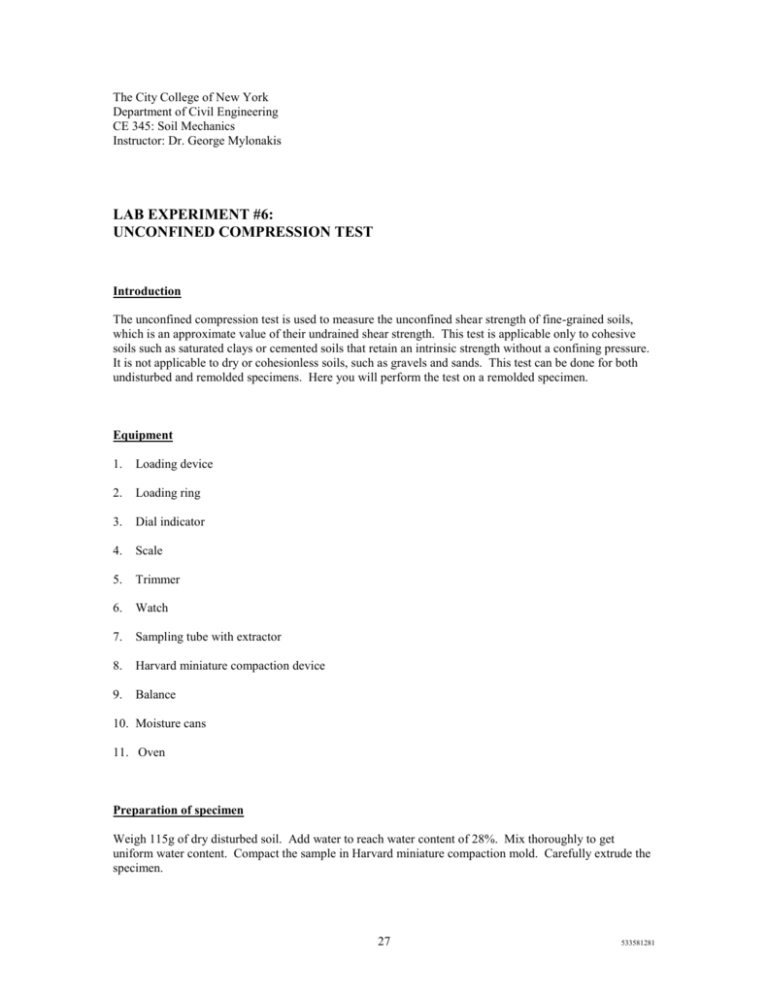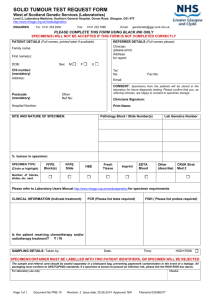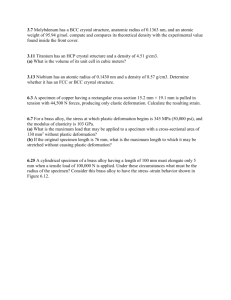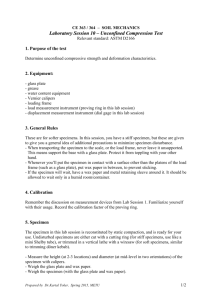L6 Unconfined Compre..
advertisement

The City College of New York Department of Civil Engineering CE 345: Soil Mechanics Instructor: Dr. George Mylonakis LAB EXPERIMENT #6: UNCONFINED COMPRESSION TEST Introduction The unconfined compression test is used to measure the unconfined shear strength of fine-grained soils, which is an approximate value of their undrained shear strength. This test is applicable only to cohesive soils such as saturated clays or cemented soils that retain an intrinsic strength without a confining pressure. It is not applicable to dry or cohesionless soils, such as gravels and sands. This test can be done for both undisturbed and remolded specimens. Here you will perform the test on a remolded specimen. Equipment 1. Loading device 2. Loading ring 3. Dial indicator 4. Scale 5. Trimmer 6. Watch 7. Sampling tube with extractor 8. Harvard miniature compaction device 9. Balance 10. Moisture cans 11. Oven Preparation of specimen Weigh 115g of dry disturbed soil. Add water to reach water content of 28%. Mix thoroughly to get uniform water content. Compact the sample in Harvard miniature compaction mold. Carefully extrude the specimen. 27 533581281 Procedure 1. Determine the initial length and diameter of the specimen. 2. Immediately place the sample on the loading device. Lower the bottom platen or raise the bottom platen so that the upper platen barely touches the specimen and triggers a slight response of the load sensor. Attach the dial indicator to the loading device to measure the axial deformation of the specimen. 3. Adjust the rate of axial displacement to obtain a strain rate of 1% per minute. The complete loading lasts about 20 min. to apply 20% of axial strain. 4. Simultaneously record the axial displacement and load. Stop the test when load remains constant or after 20% axial strain. 5. Record the time to peak strength and failure pattern (shear or bulge failure) and sketch the failed specimen. 6. After the test, determine the water content, w, of the specimen. Calculation 1. Water content w is given by w = (Wi / Wd - 1) x 100 (%) Wi = initial weight Wd = dry weight 2. The axial strain is = H / Ho H = change of specimen height Ho = initial specimen height 3. The stress is given by = F / Ac Ac = Ai / (1 - ) where, F = applied load Ac = corrected area Ai = initial area General Comments Plot a stress-strain diagram using same scale. Determine shear strength of soil. Discuss the soil tested based on results. 28 533581281 DATA SHEET: Unconfined Compression Test Description of soil: Group No.: Date: _______________________________ ______________________________________ _____________________________________________ Moisture content, w: _______________________________ % Initial length of specimen, Ho: ________________________ in. Initial diameter of specimen, Do: ________________________ in. Initial area of specimen, Ai: ________________________ in.2 Corrected area of specimen, Ac: ________________________ in.2 Force, F (lb) Displacement, H (in.) Strain, Stress, (psi) Shear Strength, ________________ psi 29 533581281






